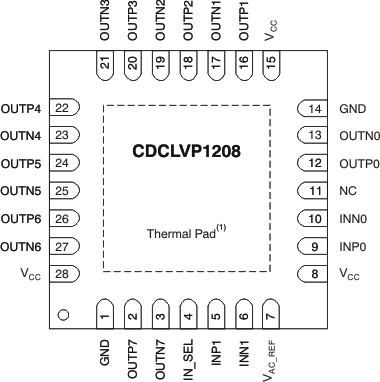SCAS890E October 2009 – November 2015 CDCLVP1208
PRODUCTION DATA.
- 1 Features
- 2 Applications
- 3 Description
- 4 Revision History
- 5 Pin Configuration and Functions
-
6 Specifications
- 6.1 Absolute Maximum Ratings
- 6.2 ESD Ratings
- 6.3 Recommended Operating Conditions
- 6.4 Thermal Information
- 6.5 Electrical Characteristics: LVCMOS Input
- 6.6 Electrical Characteristics: Differential Input
- 6.7 Electrical Characteristics: LVPECL Output, at VCC = 2.375 V to 2.625 V
- 6.8 Electrical Characteristics: LVPECL Output, at VCC = 3 V to 3.6 V
- 6.9 Pin Characteristics
- 6.10 Timing Requirements
- 6.11 Typical Characteristics
- 7 Parameter Measurement Information
- 8 Detailed Description
- 9 Applications and Implementation
- 10Power Supply Recommendations
- 11Layout
- 12Device and Documentation Support
- 13Mechanical, Packaging, and Orderable Information
Package Options
Mechanical Data (Package|Pins)
- RHD|28
Thermal pad, mechanical data (Package|Pins)
- RHD|28
Orderable Information
5 Pin Configuration and Functions
RHD Package
28-Pin QFN
Top View

1. Thermal pad must be soldered to ground.
Pin Functions
| PIN | TYPE | DESCRIPTION | |
|---|---|---|---|
| NAME | NUMBER | ||
| GND | 1, 14 | Ground | Device grounds |
| INP0, INN0 | 9, 10 | Input | Differential input pair or single-ended input. Unused input pair can be left floating. |
| INP1, INN1 | 5, 6 | Input | Redundant differential input pair or single-ended input. Unused input pair can be left floating. |
| IN_SEL | 4 | Input | Pulldown (see Pin Characteristics)
MUX select input for input choice (see Table 1) |
| OUTP7, OUTN7 | 2, 3 | Output | Differential LVPECL output pair no. 7. Unused output pair can be left floating. |
| OUTP6, OUTN6 | 26, 27 | Output | Differential LVPECL output pair no. 6. Unused output pair can be left floating. |
| OUTP5, OUTN5 | 24, 25 | Output | Differential LVPECL output pair no. 5. Unused output pair can be left floating. |
| OUTP4, OUTN4 | 22, 23 | Output | Differential LVPECL output pair no. 4. Unused output pair can be left floating. |
| OUTP3, OUTN3 | 20, 21 | Output | Differential LVPECL output pair no. 3. Unused output pair can be left floating. |
| OUTP2, OUTN2 | 18, 19 | Output | Differential LVPECL output pair no. 2. Unused output pair can be left floating. |
| OUTP1, OUTN1 | 16, 17 | Output | Differential LVPECL output pair no. 1. Unused output pair can be left floating. |
| OUTP0 OUTN0 | 12, 13 | Output | Differential LVPECL output pair no. 0. Unused output pair can be left floating. |
| VAC_REF | 7 | Output | bias voltage output for capacitive coupled inputs. Do not use VAC_REF at VCC < 3 V. If used, it is recommended to use a 0.1-μF capacitor to GND on this pin. The output current is limited to 2 mA. |
| VCC | 8, 15, 28 | Power | 2.5-/3.3-V supplies for the device |
| NC | 11 | — | Do not connect |
Table 1. Input Selection Table
| IN_SEL | ACTIVE CLOCK INPUT |
|---|---|
| 0 | INP0, INN0 |
| 1 | INP1, INN1 |